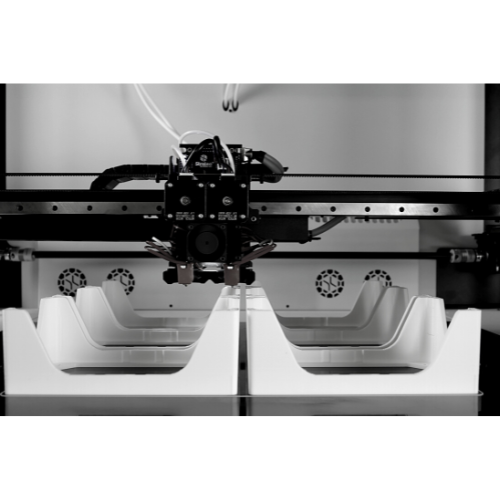3D printed objects can be used for a wide range of functional purposes, including both structural and decorative applications. Many people still perceive 3D printed objects as mere artifacts for showcasing or learning purposes, but this technology has transcended the domain of simple showpieces.
The answer is a clear ‘yes’ – 3D printed objects can indeed be used for functional purposes, and in this blog post, we will explore the various applications of 3D printing.
Examples of functional applications for 3D printed objects
3D printing allows for the production of objects with complex shapes and internal geometries that may be difficult or impossible to create using traditional manufacturing methods. This makes it possible to create functional objects with unique properties and capabilities.
Here are a few more examples of functional applications for 3D printed objects:
Structural Components for Aviation
Companies are harnessing the power of 3D printing to manufacture lightweight, high-strength components for aircraft. In addition to creating brackets that securely hold the aircraft’s engines in place, they can design complex spars to support the wings. For example, 3D printing was instrumental in developing Airbus A350 XWB’s titanium pylon, a primary component attaching the engine to the wing, showcasing significant weight reduction. This technology also empowers manufacturers to produce intricate lattice structures that provide optimal strength-to-weight ratio, essential in aircraft design.
Patient-Specific Medical Devices
The healthcare industry is capitalizing on 3D printing to create custom prosthetics precisely tailored to individual patients. For instance, a company might construct a prosthetic limb with exact specifications, conforming flawlessly to the patient’s remaining limb. Advances have also led to innovations like 3D-printed bionic arms that not only replicate physical functionality but also restore a sense of touch. Further, 3D printing is crucial in producing customized orthotic devices such as braces or splints, significantly enhancing the comfort and mobility of patients with musculoskeletal conditions.
Bespoke Consumer Products
3D printing technology is changing the landscape of consumer goods by enabling personalized product designs. From crafting phone cases that snugly fit specific models to home decor items reflecting the customer’s aesthetic sense, the possibilities are boundless. 3D printing can create an array of unique items, like intricately designed lampshades or geometrically complex jewelry pieces that traditional manufacturing processes would struggle to produce. The technology also allows for rapid prototyping, allowing customers to review and adjust their designs before final production.
Customized Automotive Parts
3D printing’s ability to produce customized automotive parts is revolutionizing the automotive industry. For instance, companies might construct brackets for custom headlights, or design intricate exhaust manifolds optimized for performance. The technology has also facilitated the creation of custom car interiors, allowing customers to express their personal style down to the smallest detail. Even more impressively, entire car bodies, like the Blade supercar by Divergent 3D, have been 3D printed, showcasing the technology’s potential in automotive design.
Aerospace Components
The aerospace industry is using 3D printing to construct a variety of components, from structural parts to engine components. Companies might print brackets for aircraft landing gear or produce engine parts that optimize weight and strength. For instance, SpaceX uses 3D printing to produce the SuperDraco engines of their Crew Dragon spacecraft. The production of complex structures like fuel injectors becomes more feasible and cost-effective with 3D printing technology.
Medical Implants
3D printing has revolutionized the production of custom medical implants. Using a patient’s CT scan, a company can print a cranial implant that perfectly fits the patient’s skull. Custom joint replacements, tailored to the patient’s anatomy and condition, can result in improved postoperative outcomes. For instance, 3D printing has been instrumental in creating patient-specific hip implants that mimic the patient’s unique anatomy, offering better fit and potentially longer implant life.
Dental Prosthetics
The dental industry is also seeing a significant impact from 3D printing. Custom dental prosthetics, such as crowns, bridges, and dentures, can be manufactured rapidly and with high precision. For example, Align Technology uses 3D printing to produce millions of individualized clear aligners (Invisalign) every year. Traditional dental implants can also be replaced with 3D printed titanium implants, offering superior biocompatibility and longevity.
Toys and Games
In the toy industry, 3D printing opens up exciting possibilities for customization and creativity. Companies can print everything from puzzles and action figures to customized board game pieces. For instance, Hasbro has used 3D printing for creating intricate, customizable Transformers action figures. Innovative startups like The Game Crafter allow users to design and 3D print their own unique board games, giving rise to a new level of interactivity and personalization.
Wrapping up
The applications of 3D printing extend far beyond mere showpieces. Whether it’s in healthcare, automotive, aerospace, or construction, 3D printed objects are being used for a wide variety of functional purposes. As technology continues to evolve, we can expect to see even more exciting applications in the future. 3D printing is not just about creating objects; it’s about crafting the future.
